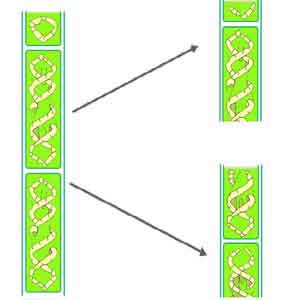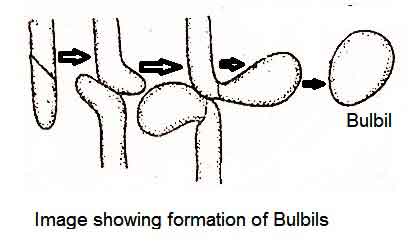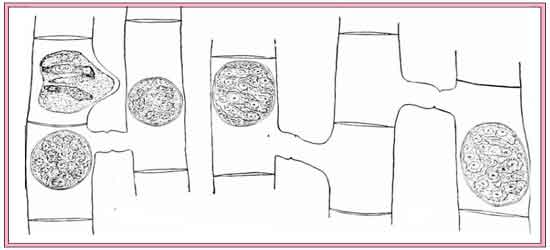Algae are a diverse group of eukaryotic cellular or multi-cellular organisms. They inhabit both in aquatic and terrestrial environments. Some occur in moist stones, wood, soils, on ice, or snow. They have photosynthetic pigments that perform photosynthesis, produce oxygen, and remove at least half of the total carbon dioxide from the earth`s atmosphere. Algae perform reproduction in various ways. It can be vegetative, asexual, or sexual. In this case, vegetative propagation occurs through fragmentation; asexual reproduction occurs by forming different spores and binary fission, while sexual reproduction occurs by fusion of two haploid gametes. Generally, many environmental factors influence the reproduction in algae.
You might also read: Structure of Algae
The following three main types of reproduction process occur in algae:
- Vegetative Reproduction
- Asexual Reproduction and
- Sexual Reproduction

Vegetative Reproduction
It is simple and the most common process of reproduction in algae. By this process, vegetative parts of thallus divide into small fragments, and each part, later on, gives rise to a new plant. This process is termed as fragmentation. This type of reproduction occurs in Spirogyra, Ulothrix, etc. In this process, no alternation of generations occurs, and it does not require any spore formation.
The vegetative reproduction in algae is of the following types:
Fission or Cell division
In this process, unicellular algae reproduce new individuals. It is a very simple method, and often it is known as binary fusion. During reproduction by this process, mitosis occurs in the vegetative cell and produces two daughter cells and finally acts as new individuals. This type of reproduction occurs in Synechococcus, Chlamydomonas, diatoms, etc.
Fragmentation
This process occurs in multi-cellular filamentous algae. In this process, the thallus breaks down into many fragments; among them, each fragment gives rise to a new individual. Generally, the fragmentation process occurs accidentally or by any other mechanical injury. This type of vegetative reproduction occurs in Ulothrix, Spirogyra, Zygnema, Oedogonium, Cylindospermum, etc.

Hormogonia
This type of reproduction occurs in blue-green algae such as Oscillatoria, Nostoc, Cylindosporium, etc. In this process, trichome breaks down within the sheath into many segments, and each segment forms a new individual. In this case, each segment is known as hormogonium.
Adventitious Branches
In many large thalloid algae, adventitious branches form and detach from the mother`s body to develop new individuals. In this case, internodes, stolons, etc. form adventitious branches. This type of reproductions occurs in Fucus, Dictyota, Chara, Cladophora, etc
Bulbils
Bulbils are the tuber-like outgrowth, which occurs due to the storage of food at the tip of the rhizoids and lower nodes of the plants. During reproduction, bulbils detach from the plant body and give rise to new individuals. This type of reproduction occurs in Charophyta, such as chara, Lamprothamnium, Nitellopsis, etc.

Amylum stars
In Chara, amylum stars occur and detach from the plant body; they develop into new plants. The cells of the lower nodes of plants store starch and form star-shaped aggregation, which is known as amylum stars.
Budding
The bud-like outgrowth occurs in some algae, such as Protosiphon. In this process, the nucleus from the parent body divides by mitosis and produces daughter nucleus, which migrates to develop bud. The newly formed buds detach from the parent body and live independently as a new individual.
Asexual Reproduction
Asexual reproduction occurs by forming a specific type of spores. In this process, some cells or protoplasm of few cells of the plant divide to create a small-sized structure, the spore. Each spore is germinated and liberated from the mother cell and gives rise to a new plant. It generally takes place by the following method:
By Forming Zoospores
In this process, under favorable conditions, biflagellate, tetra-flagellate, multi-flagellate, naked, motile zoospores are formed and on bursting of mother cells (sporangium) come out and give rise to the new plant. The zoospores may be either haploid or diploid, which are formed within the zoosporangium. In this case, biflagellate zoospores occur in Ulothrix, Chlamydomonas, Ectocarpus, etc. while tetra-flagellate zoospores occur in Ulothrix and Oedogonium, Vaucheria, multi-flagellate zoospores occur.
By Forming Aplanospores
In this case, protoplasm gets separated from the cell wall to form one or more thin-walled, non-nucleated aplanospores, and each aplanospore gives rise to a new plant. In this case, aplanospores are non-motile spores that occur inside sporangium under unfavorable conditions. This process of reproduction occurs in Chlorella, Ulothrix, Scenedesmus, Microspora, Pediastram, Sphaerella, etc.
By Forming Hypnospores
In this process, under unfavorable conditions, the protoplasm of the cells separate from the cell wall and collects in the center. These are non-motile with thickened walls and abundant food reserves, known as hypnospores. They give birth to a new plant on the commencement of favorable conditions. This process occurs in Vaucheria.
By Forming Akinetes
In certain filamentous algae, the vegetative cells become thick and develop into spore-like structures with abundant food reserves, known as akinetes. Akinets are formed under unfavorable conditions, and on commencement of favorable conditions, each akinete develops into a new plant. This type of process occurs in Cladophora, Oedogonium, etc.
By Forming Endospores
In most of the members of Myxophyceae, the development of a large number of endospores takes place inside the mother cell. Endospores germinate directly and give rise to a new plant under favorable conditions. In this case, the mother protoplasm divides and forms small spores. These spores are known as conidia or gonidia. This type of reproduction occurs in Dermocarpa.
Pamella Stage
Under dry conditions, zoospores or aplanospores don’t come outside the mother cell but get encompassed by an adhesive sheath. The division proceeds with the outcome; they take the form of a colony. This is known as the pamella stage. Under suitable conditions, they turn out. Every zoospore or aplanospore offers ascend to another plant. This procedure happens in Chlamydomonas sp.
By Autospores
In some algae, the undeveloped spores grow into new plants within the mother cell. This type of reproduction occurs in Chlorococcus.
By Cysts
In some algae, under unfavorable conditions and abundant food supply, the thallus divides into multinucleate and thick-walled smaller segments, which are termed as cysts. In favorable conditions, cysts give rise to new plants. It occurs in Vaucheria sp.
Sexual Reproduction
All the members of the algae reproduce sexually except the representatives of the class Cyanophyceae. Sexual reproduction occurs by fusion of gametes. These gametes grow within gametangia. Sexual reproductions are of the following five types:
Isogamous
In some algae, the gametes and their size and external morphology are alike. In this type of reproduction, Positive (+) and negative (-) strain gametes combine together to form zygospore or zygotes. These gametes are known as isogametes, which may be motile (zoogametes) or non-motile. In this case, isogametes of Chlamydomonas and Ulothrix are motile, while isogametes (aplanogametes) in Spirogyra are non-motile type.

Anisogamous
In some algae, the gametes and their external morphology are alike, but their behavior and size vary. In this case, the large-sized and passive gamete is known as macrogamete, while the smaller and active gamete is known as microgamete. These two gametes fuse and produce a zygote, which later on undergoes mitotic division to form new individuals. This type of reproduction occurs in Chlamydomonas.

Oogamous
In this type of sexual reproduction, fertilization occurs between small, biflagellate, or multi-flagellate, active male gamete with large non-flagellate, passive female gamete, and form zygote (oospore). In this case, male gametes grow within antheridium while the female gametes within the oogonium. This type of reproduction occurs in Oedogonium, Chlamydomonas, Vaucheria, Laminaria, Chara, Poly-siphonia, Sargassum, Batrachospermum, etc.

Concluding Remarks
Algae act as a significant component of the food chain in the aquatic ecosystem as a primary producer. Algae have a huge source of carbohydrates, lipids, proteins, and vitamins A, B, C, and E, etc. They also contain very important minerals sources for animals such as iron, magnesium, potassium, manganese, calcium, and zinc. Some algae use as human foods such as agar is used as commercial products while Graularia, Gelidium, etc. are used to grow microbes for making ice creams and jellies. Chlorella and Spirullina contain rich proteins that are used as food supplements. To make the aquatic ecosystem friendly, we should take conservation measures for protecting the algae species.

